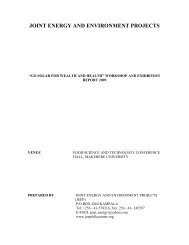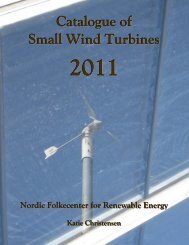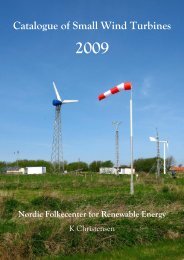You also want an ePaper? Increase the reach of your titles
YUMPU automatically turns print PDFs into web optimized ePapers that Google loves.
technology also gradually found its way into<br />
agriculture with energy production as the main<br />
purpose.<br />
At the end of the 1950s, development nearly<br />
stopped, however, due to the cheapness of the<br />
fossil fuels oil and gas. The interest in biogas<br />
was not reawakened until the mid 1970s following<br />
the oil crisis in 1973. The Danish state<br />
initiated a research and development programme<br />
with the aim of testing and constructing<br />
different types of biogas plants using animal<br />
manure as the main source of biomass.<br />
Today (2009) there are about 60 biogas facilities<br />
installed at sewage treatment plants. In<br />
addition, around 20 communal biogas plants<br />
of various sizes have been constructed to treat<br />
manure, slurry in particular, from a number of<br />
livestock farms. These biogas plants also take<br />
in large amounts of organic waste from the<br />
food industry and slaughterhouses, whereby<br />
the energy from the waste is extracted and the<br />
nutrients recycled to the agricultural sector. On<br />
top of this, there are approximately 60 on-farm<br />
facilities and a number of biogas plants associated<br />
with landfill sites and with different industries<br />
that produce waste water with a high<br />
organic content (see figure 5).<br />
From the mid 1990s, the expansion of the<br />
biogas in<br />
DeveloPing<br />
countries<br />
A number of developing<br />
countries use biogas<br />
extensively. In India<br />
and China alone,<br />
there are more than<br />
one million small,<br />
simple plants, each<br />
treating waste (sewage,<br />
animal manure,<br />
crop residues, etc.)<br />
from a single household.<br />
The plants are<br />
dug into the ground<br />
and are unheated. The<br />
biogas is used in the<br />
housekeeping for cooking<br />
and the digested<br />
biomass is used as a<br />
fertiliser (see figure 6).<br />
Sewage<br />
Animal manure<br />
Plant residues<br />
<strong>Biogas</strong> plant<br />
Food<br />
<strong>Biogas</strong> for<br />
cooking<br />
biogas sector once again stagnated in Denmark<br />
due to lack of economic incentives. But with<br />
the political agreement in Folketinget in 2008<br />
on an energy policy promoting green energy<br />
and on a better price for electricity produced<br />
from biogas, the sector is slowly starting to<br />
wake up again.<br />
Municipal sewage<br />
Number <strong>Biogas</strong> production<br />
in Denmark in 2006<br />
1,000 m 3<br />
treatment plants 61 ~ 40,000<br />
Communal biogas plants 19 ~ 73,000<br />
Farm biogas plants 57 ~ 33,000<br />
Landfill gas plants 25 ~ 18,000<br />
Industrial plants 5 ~ 7,000<br />
Total 167 ~ 171,000<br />
Total biogas production in Denmark is 4 PJ, which<br />
is about 5‰ of the total energy consumption.<br />
Figure 5. <strong>Biogas</strong> production in Denmark in 2006.<br />
Fertiliser<br />
Mulberry tree<br />
with silkworms<br />
Sludge (fertiliser)<br />
Fish pond<br />
Figure 6. An interesting ecological cycle with biogas as the central unit is practised<br />
in many places in China.

















